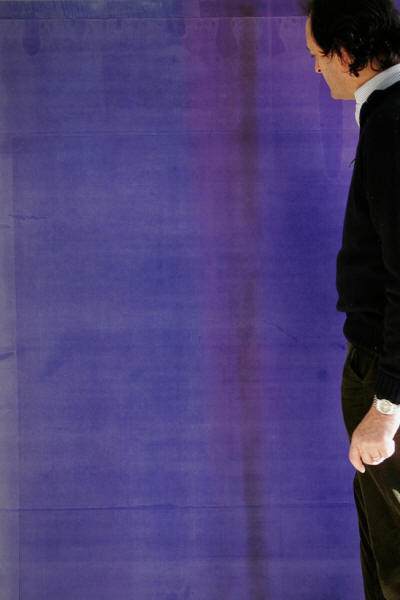Roberto Ciaccio

The originality and specificity of Roberto Ciaccio’s work allows him to be regarded as one of the most interesting and innovative figures on the contemporary art scene: In particular, the relationship of his work with contemporary philosophy, ranging from Heidegger’s thought to Merleau-Ponty’s phenomenological approach and Gilles Deleuze’s and Jacques Derrida’s more recent reflections, has had important consequences, both at a theoretical level and with regard to his artistic practice.
Conferences and round tables on the themes of art and philosophy have been devoted to his work, with the participation of distinguished scholars, Italian and otherwise (for instance, Jacques Derrida, Remo Bodei and Arturo Schwarz), including the conference devoted to him by the Staatliche Museen in Berlin on the occasion of the exhibition ‘Revenants’.
The whole of the artist’s work is characterized by the poetics of the revenance. In the depth and transparency of the works — on paper and plates — the revenants of the figures (matrices) appear and disappear in a state of mirroring and memory.
The dimension of revenance — as specified by the artist — finds, in the work, its point of contact with resonance, sharing with this an allusion to an inner sound.
On the borderline between sculpture and architecture in a practice that regards the installation of the work as the constitutive moment of the artist’s thought in his creative procedure, Ciaccio’s work involves the exhibition space in a dynamic process of visual and structural integration. Above all, the large plates of different types of metal — iron, copper, brass and zinc — with their physicality and brightness and, in some cases, reflective surfaces, establish an intriguing relationship with the spaces housing them. The metal plates form illusory three-dimensional spaces within themselves through the multiple stratification of the planes and colour and light values of the metals.
The motives for creating a dialogue between Ciaccio’s work and architecture are to be found in the possible parallels with the distinctive features of the exhibition spaces and also in the very nature of the materials constituting the works. The artist produces long series of metal plates with a rhythm or interval that defines their continuity and reciprocity, or else large walls are constructed as a result of the simultaneity of the juxtaposition of the large plates that are either intensely bright or very dark and are able to create a strong resonance with the surrounding space.
The colour characteristics and the rhythm of the variations of light in the series of works induce an intensely musical visual impression in which the intervallic tension and the reverberation of the sound assume particular importance. Ciaccio’s work has, in fact, inspired original pieces for piano.
Having developed with a focus on the original print, in a long collaboration with the printer Giorgio Upiglio in Milan, Ciaccio’s work has questioned its underlying principles in a metalinguistic redefinition of the tools and processes involved in this medium. Paradoxically, the concept of matrix, seriality and technical reproducibility appear to have been redefined.
In the course of the creative process, the large matrix plates — used to produce monoprints and monotypes — become works in their own right that are both totally independent and very expressive. The Kupferstichkabinett in Berlin, with the exhibition ‘Revenants’, and the Istituto Nazionale per la Grafica in Rome have emphasized the artist’s role in an innovative path of praxis and thought concerning this area of artistic investigation.